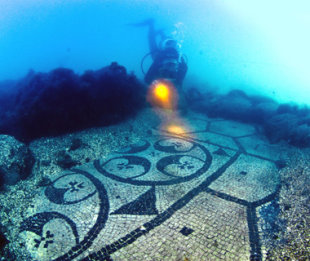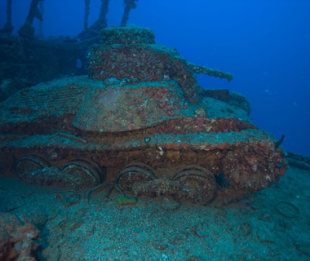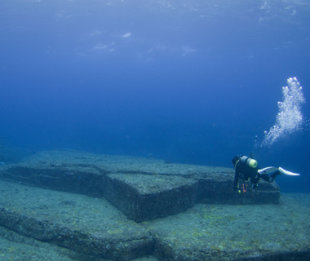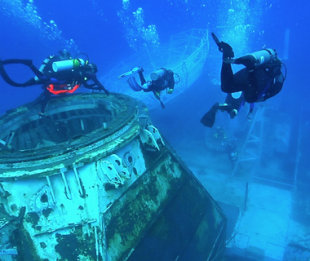MORE AT TRAVEL+LEISURE
We’re just beginning to appreciate the depth of the ocean’s wonders, as demonstrated by director James Cameron’s recent seven-mile free fall to the lowest point of the Mariana Trench, roughly 50 times the size of the Grand Canyon.
While Cameron’s not eager to promote deep-sea tourism, inspired travelers might be surprised by how much we already have to gawk at below the waves. The coolest underwater attractions include ancient ruins, shipwrecks, art, and kitsch—and you don’t necessarily need to be a scuba diver to enjoy them.
Take the plunge now to explore these cool underwater attractions. It’s a brave new world down there.
Museo Subacuático de Arte, Cancún, Mexico
British artist Jason deCaires Taylor’s under-the-sea museum features more than 400 pieces molded from pH-neutral concrete and sunk in Cancún’s National Marine Park off Isla Mujeres (a much larger endeavor than his first sculpture park in Grenada’s Moliniere Bay). Look out for the orange coral–studded “Man on Fire” and Terracotta Army–esque “Silent Evolution.” Corals and sea life will gradually stake a claim on the figures, transforming them into living reefs to surreal effect. You can visit via snorkel, scuba, or glass-bottomed boat.
Parco Archaeologico Sommerso di Baia, Pozzuoli, Italy
Pompeii doesn’t have the lock on ancient Italian trauma. Thanks to bradyseism—the gradual raising or lowering of earth due to filling magma chambers—the neighborhood of Baia, 30 minutes west of Naples, now rests in about five to 15 feet of water. Guided tours for both snorkelers and divers cover eight underwater (and four terrestrial) sites like Villa Protiro and Portus Julius. Intricate black-and-white mosaic floors, loose statues, and frescoes mingle with sea stars and anemone shoals...for now. As recently as 1984, the sea floor raised six feet.
Truk Lagoon, Micronesia
At the top of even the most casual wreck enthusiast’s bucket list, Truk (a.k.a. Chuuk) was the forward stronghold of Japan’s Imperial Navy during World War II before it was bombed into oblivion in February 1944. The coral-encrusted ghost fleet (some 60 ships, 275 airplanes)—with gas masks, ammunition, guns, and bones still rattling inside—litters the sandy floor at an average depth of 65 feet. The lagoon’s calm waters host reef sharks and a rainbow of fish, as seemingly in paradise as the divers photographing rusted artillery tanks aboard the San Francisco Maru and the shattered hulk of the I-169 Shinohara submarine.
Neptune Memorial Reef, Key Biscayne, Florida
Introducing the first cemetery that requires PADI certification to pay your respects. The founding Neptune Society has taken burial at sea to a monumental level with what will ultimately be the world’s largest man-made reef: 16 acres sprawled under 50 feet of water about three miles east of Key Biscayne, near South Beach. Modeled after Atlantis, with stone lions guarding an entrance canopy and porticos, the reef has space in its first phase for 850 “placements”—cremated remains mixed with concrete and put into niches or molded into shell and coral shapes on the sea floor. The ultimate capacity will reach 125,000.
Port Royal, Jamaica
It wasn’t rum or syphilitic excess that undid the 17th-century Caribbean’s notorious hotbed of piracy and privateering, so dubbed “the Wickedest City on Earth.” It was bad urban planning. Port Royal was built on a sand spit, and when an earthquake struck on June 7, 1692, liquefaction caused 33 acres, streets and all, to sink. Today, it’s one of the New World’s best nautical archaeological sites, with depths reaching 40 feet. Consult dive shops for permits to explore paving stones, parts of the former city wall, and nearby wrecks.
Yonaguni Monument, Okinawa, Japan
A sport diver tracking hammerhead sharks in 1987 discovered a megalithic temple 82 feet under the East China Sea: solid rock slabs, carved with near right angles in a stepped pyramidal structure; ancient walls and water channels; stone tools and carvings. Or did he? Japanese scientists proclaimed it the Lost Continent of Mu. Dissenters chalked it up as a unique, though natural phenomenon, like the basalt columns of the Giant’s Causeway. What’s not up for geological debate: the flights of fantasy you get from diving here.
Underwater Post Office, Vanuatu
At the world’s first underwater post office, 150 feet out and nine feet down off marine sanctuary Hideaway Island, it’s not slow-moving lines of humans you have to contend with but schools of shimmering fish. Cyclone Jasmine damaged the structure in February 2012, so for now scuba-gear-clad mailmen have been replaced by an unmanned yellow post box; about $4 still gets you a waterproof postcard mailed anywhere in the world.
Weeki Wachee Mermaid Show, Spring Hill, FL
Fed by the massive Weeki Wachee Springs, the Mermaid Show Theater an hour north of Tampa is an aquatic cousin to the terrestrial tackiness of road-trip classics like South Dakota’s Corn Palace and Route 66’s dusty concrete dinosaurs. Campy, you betcha! It’s a slice of Americana layered on thick. And yet, in the right mood, its old-time charm and balletic prowess—and occasional stage crash by a pirouetting manatee—is enchanting nostalgia, an act largely unchanged since pretty girls first donned fabric tails in 1947.
Florida Keys Shipwreck Trail
Stretching 120 miles from Key Largo to Key West, this aggressive artificial reef program supplements the area’s shallow, fish-filled reefs and wrecks of early 1700s Spanish galleons. Free dive logs highlight the main sites, such as the massive radar dishes of the 524-foot-long missile tracker USS Vandenberg, host to an underwater photo exhibit. North of Key Largo, near Miami, The Spirit of Miami—an entire Boeing 727 jetliner sunk in Biscayne Bay in 1993—was subsequently lost during a tropical storm and rediscovered in multiple pieces in 2010.
Vaersenbaai Car Piles, Curaçao
Divers know the candy-colored island of Curaçao for the Marine Park all along its southern coast, offering easy shore dives and snorkeling, sheer drop-offs, and coral bays. There are wrecks for beginners (a cutesy tugboat) and, for the more technically skilled, car piles roughly 90 feet down. Classic rides from the ’40s and ’50s were junked in Vaersenbaai along with cranes and construction equipment in an ill-conceived attempt at reef building. But where sponge and coral didn’t quite flourish, photo-ops do—namely you behind the wheel of a rusty Chevy.
See More of the Coolest Underwater Attractions











No comments:
Post a Comment